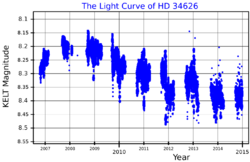Astronomy:HD 34626
| Observation data Equinox J2000.0]] (ICRS) | |
|---|---|
| Constellation | Auriga |
| Right ascension | 05h 20m 33.03590s[2] |
| Declination | +36° 37′ 56.0306″[2] |
| Apparent magnitude (V) | 8.16[3] |
| Characteristics | |
| Spectral type | B1.5 IVnp[4] |
| U−B color index | −0.68[5] |
| B−V color index | +0.03[5] |
| Variable type | SX Ari?[6] |
| Astrometry | |
| Radial velocity (Rv) | −6[7] km/s |
| Proper motion (μ) | RA: −0.630[2] mas/yr Dec.: −4.017[2] mas/yr |
| Parallax (π) | 0.9831 ± 0.0356[2] mas |
| Distance | 3,300 ± 100 ly (1,020 ± 40 pc) |
| Details | |
| Mass | 4.4[2] M☉ |
| Radius | 21[2] R☉ |
| Luminosity | 556[2] L☉ |
| Temperature | 22,675[3] K |
| Rotational velocity (v sin i) | 310[8] km/s |
| Age | 200[9] Myr |
| Other designations | |
MZ Aurigae, MZ Aur, BD+36°1090, HD 34626, HIP 24938, SAO 57915. | |
| Database references | |
| SIMBAD | data |
HD 34626, also known as MZ Aurigae, is an unusual variable star in the northern constellation of Auriga. It has an apparent magnitude of 8.2 and is about 3,300 light years away.
The spectrum of HD 34626 had long been known to be unusual, with very broad lines indicating rapid rotation and emission lines marking it as a Be star. In 1970, it was found to vary in brightness by 0.1 magnitude over time scales of 8 to 12 hours, but these variations are not periodic.[10] This indicates the variability is not caused by ellipsoidal effects, and the nature of the variability remains unknown.[8] It may be a type of SX Arietis variable.[6]
HD 34626 has exhausted its core hydrogen and evolved away from the main sequence. Its spectral type indicates that it is a subgiant, but evolutionary models suggest it may be in the giant stage.[2]
References
- ↑ Labadie-Bartz, Jonathan; Pepper, Joshua; McSwain, M. Virginia; Bjorkman, J. E.; Bjorkman, K. S.; Lund, Michael B.; Rodriguez, Joseph E.; Stassun, Keivan G. et al. (May 2017). "Photometric Variability of the Be Star Population". The Astronomical Journal 153 (6): 252. doi:10.3847/1538-3881/aa6396. Bibcode: 2017AJ....153..252L.
- ↑ Jump up to: 2.0 2.1 2.2 2.3 2.4 2.5 2.6 2.7 2.8 Vallenari, A. et al. (2022). "Gaia Data Release 3. Summary of the content and survey properties". Astronomy & Astrophysics. doi:10.1051/0004-6361/202243940 Gaia DR3 record for this source at VizieR.
- ↑ Jump up to: 3.0 3.1 Hohle, M. M. et al. (April 2010), "Masses and luminosities of O- and B-type stars and red supergiants", Astronomische Nachrichten 331 (4): 349–360, doi:10.1002/asna.200911355, Bibcode: 2010AN....331..349H
- ↑ Walborn, N. R. (1971). "Some Spectroscopic Characteristics of the OB Stars: An Investigation of the Space Distribution of Certain OB Stars and the Reference Frame of the Classification". The Astrophysical Journal Supplement Series 23: 257. doi:10.1086/190239. Bibcode: 1971ApJS...23..257W.
- ↑ Jump up to: 5.0 5.1 Deutschman, W. A.; Davis, R. J.; Schild, R. E. (February 1976), "The galactic distribution of interstellar absorption as determined from the Celescope catalog of ultraviolet stellar observations and a new catalog of UBV, H-beta photoelectric observations", Astrophysical Journal Supplement Series 30: 97–225, doi:10.1086/190359, Bibcode: 1976ApJS...30...97D
- ↑ Jump up to: 6.0 6.1 "MZ Aur". AAVSO. https://www.aavso.org/vsx/index.php?view=detail.top&oid=4050.
- ↑ Gontcharov, G. A. (November 2006). "Pulkovo Compilation of Radial Velocities for 35 495 Hipparcos stars in a common system". Astronomy Letters 32 (11): 759–771. doi:10.1134/S1063773706110065. Bibcode: 2006AstL...32..759G.
- ↑ Jump up to: 8.0 8.1 Percy, J. R. (December 1984), "Five suspected Beta Cephei stars revisited", Journal of the Royal Astronomical Society of Canada 78: 241–250, Bibcode: 1984JRASC..78..241P
- ↑ Tetzlaff, N.; Neuhäuser, R.; Hohle, M.M. (January 2011). "A catalogue of young runaway Hipparcos stars within 3 kpc from the Sun". Monthly Notices of the Royal Astronomical Society 410 (1): 190–200. doi:10.1111/j.1365-2966.2010.17434.x. Bibcode: 2011MNRAS.410..190T.
- ↑ Percy, J. R. (1970). "A photometric study of some early B stars whose spectral lines vary in sharpness". The Astronomical Journal 75: 818. doi:10.1086/111026. Bibcode: 1970AJ.....75..818P.
External links
 |


